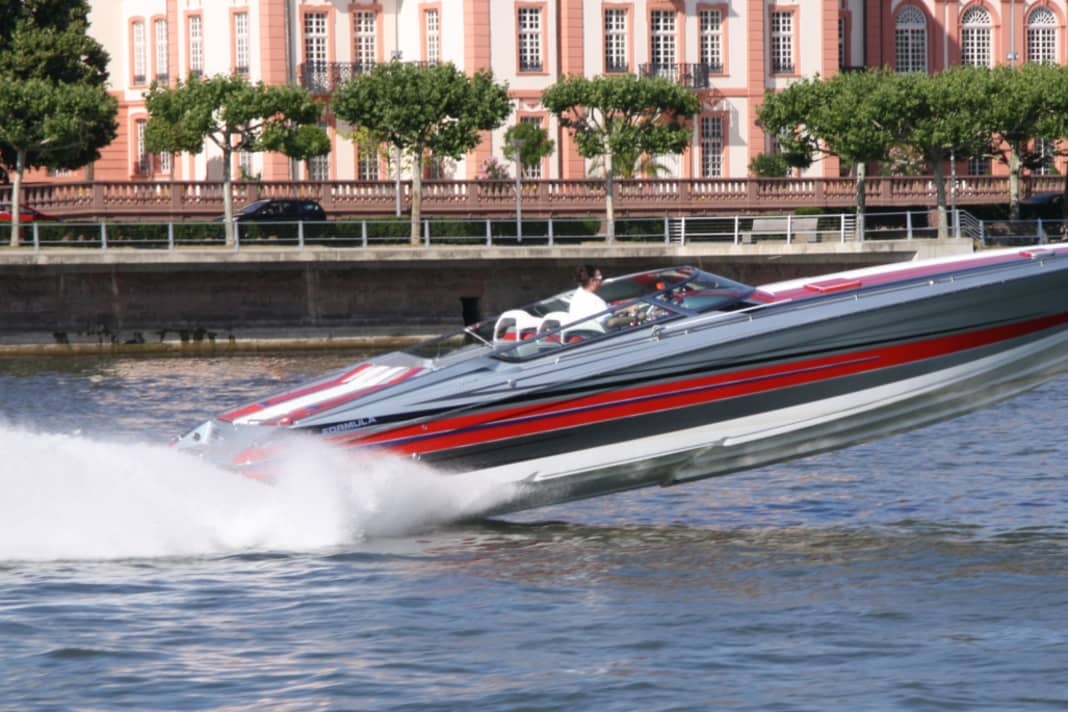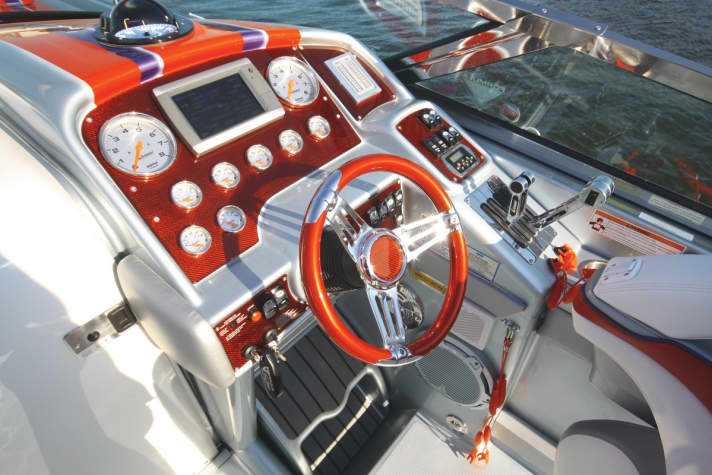Thunderbird Formula 382 Fas3tech - Formula 382 Fas3tech with up to 1450 hp
Peter Laessig
· 05.08.2015







The boat manufacturer Formula can look back on several decades of history. It all started with the Thunderbird boat brand, which Woodie Woodson first launched on the market in 1956. Then Don Aronow, the father and inventor of the deep-V hull, appeared on the scene and founded the Formula shipyard in 1962. Whoever says Aronow must also mention his "offshoots" Donzi, Magnum and the still legendary Cigarette in the same breath. The Formula 233 was one of his first deep-V hulls, with which he won races.
Formula was later bought by the same company that had previously acquired Thunderbird, and Thunderbird-Formula in turn became the property of the Porter family in 1976 - and remains so to this day.
It was then that the company began its uninterrupted rise. The boats were initially marketed under the name "Thunderbird" and were first offered in Germany in 1974. Shortly afterwards, they were simply called "Formula".
From the very beginning, the shipyard focussed on uncompromising quality down to the smallest detail. It goes without saying that the best materials are used and the highest precision is emphasised in the construction of the boats. The company has also always consistently pursued the path of improving the boat and hull. One result is today's FAS³TECH hull, which was first presented in 1996 and is characterised by its excellent running and extremely smooth rough water behaviour. It has a deep V-hull with a 24-degree upturn, which ensures smooth running in waves and rough water, and transverse steps reduce water resistance.
The engine selection for the Fomula 382 FAS³TECH ranges from a 300 hp petrol engine to two 725 hp engines. Diesel engines are also available, from one 400 hp to two 500 hp engines. And for Lake Constance, Ilmor can install either a V8 with 372 hp or the same in a twin pack with catalytic converter and Lake Constance approval.
We drive the Formula 382 FAS³TECH with two Ilmor MV10s, each producing 725 hp from a displacement of 8.4 litres. Propulsion is provided by two Indy-Z drives from the same company, on which counter-rotating stainless steel propellers are mounted. These are surface drives. This means that the propellers are not located deep in the water, as is the case with conventional drives, but close to the surface. And when travelling, the propellers work both in the water and in the air. The characteristic feature of this type of propulsion is the water plumes or "roostertails", which spread out behind the boats while they are travelling.
However, these drives and propellers also prevent the boat from turning in the narrowest of spaces in the harbour, as is usually the case with counter-rotating drives when one is set to "ahead" and the other to "astern". It works if you allow the propeller turning in reverse to turn faster. Otherwise, when both gears are set to "ahead", the boat turns a full circle within just under two boat lengths. At the lowest speeds (650 rpm), you are travelling at 5.6 knots, and if you only shift one drivetrain, one knot slower.


As is usual for surface drives, there are only two speed levels, slow as a displacer or fast as a glider. The limit is 3000 rpm plus fully extended trim tabs and fully trimmed drives. Then you are travelling at around 23 knots. These settings should also be maintained if you want to keep the foresight at the slowest gliding speed. If the trim tabs remain fully extended, the engines do not turn higher than 4000 rpm at full throttle and you have the feeling of travelling with the handbrake on, but also with spectacular trim tab fountains.
The Formula 382 FT is undoubtedly a driving machine that wants to be fine-tuned at every speed, which means that power trim and trim tabs have to harmonise. The power trim in particular requires a "sensitive touch", as the trim ultimately determines the speed.
If the speeds and trim do not harmonise, the 382 FT tends to luff, but without rocking. If all the parameters are right, the boat with the V10 Ilmor engines is travelling at just under 84 knots - according to the shipyard measurement. We didn't quite manage that on the Rhine; as we were travelling with full tanks, we were 4 kn short.
Anyone who thinks that the whole thing is associated with ruckus and noise is mistaken. The exhaust fumes are channelled into the water through a silencer. At cruising speed, we measured 78 dB/A at the helm, and cruising speed means 3000 rpm. For the consumption measurements, we refer to shipyard data, where you can theoretically travel just under 160 nm at slow speed (6 knots) with one tank of fuel, plus 15% reserve. Economically, you are travelling between 3000-4000 rpm at a speed of 31-51 knots and can cover a distance of around 180 nm, at full throttle just under 120 nm, until the reserve is used up.
We tackled the fast bends on the Rhine with the propulsion trimmed all the way down and at a speed of 50 knots. On tighter bends at high speed, it is also important to set the drives to the lowest position, otherwise the boat starts to buck and rock sideways, with a tendency to hook in easily. Slow turns, on the other hand, do not cause any problems.
The driver and co-driver sit or stand in the finest seating "as safe as in Abraham's lap". A feast for the eyes is the driving position, which will make any technology enthusiast's eyes light up. However, the boat's windscreen is too low for us - you get the full force of the airstream. If that bothers you, you have no choice but to duck down. Almost forgotten: There is also a cabin with a bunk as well as a fridge, separate toilet room and sun lounger, and there is plenty of storage space throughout the boat.
Conclusion:
Even though the Formula FAS³TECH has been on the market for some time, it remains an appealing boat that stands out from the crowd in a positive way - and requires the rider to have a feel for trimming.

